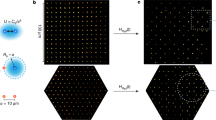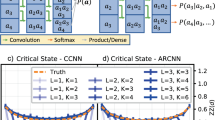Abstract
Quantum state tomography is the standard technique for estimating the quantum state of small systems1. But its application to larger systems soon becomes impractical as the required resources scale exponentially with the size. Therefore, considerable effort is dedicated to the development of new characterization tools for quantum many-body states2,3,4,5,6,7,8,9,10,11. Here we demonstrate matrix product state tomography2, which is theoretically proven to allow for the efficient and accurate estimation of a broad class of quantum states. We use this technique to reconstruct the dynamical state of a trapped-ion quantum simulator comprising up to 14 entangled and individually controlled spins: a size far beyond the practical limits of quantum state tomography. Our results reveal the dynamical growth of entanglement and describe its complexity as correlations spread out during a quench: a necessary condition for future demonstrations of better-than-classical performance. Matrix product state tomography should therefore find widespread use in the study of large quantum many-body systems and the benchmarking and verification of quantum simulators and computers.
This is a preview of subscription content, access via your institution
Access options
Access Nature and 54 other Nature Portfolio journals
Get Nature+, our best-value online-access subscription
$32.99 / 30 days
cancel any time
Subscribe to this journal
Receive 12 print issues and online access
$259.00 per year
only $21.58 per issue
Buy this article
- Purchase on SpringerLink
- Instant access to full article PDF
Prices may be subject to local taxes which are calculated during checkout




Similar content being viewed by others
References
Vogel, K. & Risken, H. Determination of quasiprobability distributions in terms of probability distributions for the rotated quadrature phase. Phys. Rev. A 40, 2847–2849 (1989).
Cramer, M. et al. Efficient quantum state tomography. Nat. Commun. 1, 149 (2010).
Gross, D., Liu, Y.-K., Flammia, S. T., Becker, S. & Eisert, J. Quantum state tomography via compressed sensing. Phys. Rev. Lett. 105, 150401 (2010).
Flammia, S. T. & Liu, Y.-K. Direct fidelity estimation from few Pauli measurements. Phys. Rev. Lett. 106, 230501 (2011).
da Silva, M. P., Landon-Cardinal, O. & Poulin, D. Practical characterization of quantum devices without tomography. Phys. Rev. Lett. 107, 210404 (2011).
Baumgratz, T., Gross, D., Cramer, M. & Plenio, M. B. Scalable reconstruction of density matrices. Phys. Rev. Lett. 111, 020401 (2013).
Baumgratz, T., Nüßeler, A., Cramer, M. & Plenio, M. B. A scalable maximum likelihood method for quantum state tomography. New J. Phys. 15, 125004 (2013).
Tóth, G. et al. Permutationally invariant quantum tomography. Phys. Rev. Lett. 105, 250403 (2010).
Cramer, M. et al. Spatial entanglement of bosons in optical lattices. Nat. Commun. 4, 2161 (2013).
Shabani, A. et al. Efficient measurement of quantum dynamics via compressive sensing. Phys. Rev. Lett. 106, 100401 (2011).
Steffens, A. et al. Towards experimental quantum-field tomography with ultracold atoms. Nat. Commun. 6, 7663 (2015).
Schollwöck, U. The density-matrix renormalization group in the age of matrix product states. Ann. Phys. 326, 96–192 (2011).
Fannes, M., Nachtergaele, B. & Werner, R. F. Finitely correlated states on quantum spin chains. Commun. Math. Phys. 144, 443–490 (1992).
Hastings, M. B. Solving gapped Hamiltonians locally. Phys. Rev. B 73, 085115 (2006).
Brandao, F. G. S. L. & Horodecki, M. An area law for entanglement from exponential decay of correlations. Nat. Phys. 9, 721–726 (2013).
Lieb, E. & Robinson, D. The finite group velocity of quantum spin systems. Commun. Math. Phys. 28, 251–257 (1972).
Nachtergaele, B. & Sims, R. Much ado about something: why Lieb–Robinson bounds are useful. IAMP News Bull. 4, 22–29 (2010).
Cheneau, M. et al. Light-cone-like spreading of correlations in a quantum many-body system. Nature 481, 484–487 (2012).
Brandão, F. G. S. L. & Horodecki, M. Exponential decay of correlations implies area law. Commun. Math. Phys. 333, 761–798 (2015).
Kim, I. H. On the informational completeness of local observables. Preprint at http://arXiv.org/abs/1405.0137v1 (2014).
Eisert, J. & Osborne, T. J. General entanglement scaling laws from time evolution. Phys. Rev. Lett. 97, 150404 (2006).
Bravyi, S., Hastings, M. B. & Verstraete, F. Lieb–Robinson bounds and the generation of correlations and topological quantum order. Phys. Rev. Lett. 97, 050401 (2006).
Jurcevic, P. et al. Quasiparticle engineering and entanglement propagation in a quantum many-body system. Nature 511, 202–205 (2014).
Jurcevic, P. et al. Spectroscopy of interacting quasiparticles in trapped ions. Phys. Rev. Lett. 115, 100501 (2015).
Hauke, P. & Tagliacozzo, L. Spread of correlations in long-range interacting quantum systems. Phys. Rev. Lett. 111, 207202 (2013).
Haffner, H. et al. Scalable multiparticle entanglement of trapped ions. Nature 438, 643–646 (2005).
Schachenmayer, J., Lanyon, B. P., Roos, C. F. & Daley, A. J. Entanglement growth in quench dynamics with variable range interactions. Phys. Rev. X 3, 031015 (2013).
Richerme, P. et al. Non-local propagation of correlations in quantum systems with long-range interactions. Nature 511, 198–201 (2014).
Schindler, P. et al. A quantum information processor with trapped ions. New J. Phys. 15, 123012 (2013).
Sidje, R. B. A software package for computing matrix exponentials. ACM Trans. Math. Softw. 24, 130–156 (1998).
Jones, E., Oliphant, T. & Peterson, P. et al. SciPy: Open Source Scientific tools for Python (2001); http://www.scipy.org
Ježek, M., Fiurášek, J. & Hradil, Z. Quantum inference of states and processes. Phys. Rev. A 68, 012305 (2003).
Plenio, M. B. Logarithmic negativity: a full entanglement monotone that is not convex. Phys. Rev. Lett. 95, 090503 (2005).
Sabín, C. & García-Alcaine, G. A classification of entanglement in three-qubit systems. Eur. Phys. J. D 48, 435–442 (2008).
Perez-Garcia, D., Verstraete, F., Wolf, M. M. & Cirac, J. I. Matrix product state representations. Quantum Inf. Comput. 7, 401–430 (2007).
Baumgratz, T. Efficient System Identification and Characterization for Quantum Many-body Systems PhD thesis, Ulm University (2014).
Nielsen, M. A. & Chuang, I. L. Quantum Computation and Quantum Information 9th edn (Cambridge Univ. Press, 2007).
Osborne, T. J. Efficient approximation of the dynamics of one-dimensional quantum spin systems. Phys. Rev. Lett. 97, 157202 (2006).
Acknowledgements
Work in Innsbruck was supported by the Austrian Science Fund (FWF) under the grant number P25354-N20, by the European Commission via the integrated project SIQS, by the Institut für Quanteninformation GmbH and by the US Army Research Office through grant W911NF-14-1-0103. All statements of fact, opinion or conclusions contained herein are those of the authors and should not be construed as representing the official views or policies of ARO, the ODNI, or the US Government. We thank H. Shen and T. Brydges for experimental support in the final stage of the experiment. Work in Ulm was supported by an Alexander von Humboldt Professorship, the ERC Synergy grant BioQ, the EU projects QUCHIP and EQUAM, the US Army Research Office Grant No. W91-1NF-14-1-0133 and the BMBF Verbundproject QuOReP. Numerical computations have been supported by the state of Baden-Württemberg through bwHPC and the German Research Foundation (DFG) through grant no INST 40/467-1 FUGG. I.D. acknowledges support from the Alexander von Humboldt Foundation. M.H. acknowledges contributions from D. Suess to jointly developed code used for data analysis. Work at Strathclyde is supported by the European Union Horizon 2020 collaborative project QuProCS (grant agreement 641277), and by AFOSR grant FA9550-12-1-0057. M.C. acknowledges the ERC grant QFTCMPS and SIQS, the cluster of excellence EXC201 Quantum Engineering and Space-Time Research, and the DFG SFB 1227 (DQ-mat). T.B. acknowledges EPSRC (EP/K04057X/2) and the UK National Quantum Technologies Programme (EP/M01326X/1). B.P.L. acknowledges support by the START prize of the Austrian FWF project Y 849-N20.
Author information
Authors and Affiliations
Contributions
B.P.L., C.F.R., M.B.P. and M.C. developed and supervised the project; C.M., C.H., B.P.L., P.J., R.B. and C.F.R. performed and contributed to the experiments; B.P.L., M.H., T.B., C.M., C.F.R., I.D., A.S.B. and A.J.D. performed data analysis and modelling; B.P.L. wrote the manuscript, with contributions from all authors.
Corresponding authors
Ethics declarations
Competing interests
The authors declare no competing financial interests.
Supplementary information
Supplementary information
Supplementary information (PDF 997 kb)
Rights and permissions
About this article
Cite this article
Lanyon, B., Maier, C., Holzäpfel, M. et al. Efficient tomography of a quantum many-body system. Nature Phys 13, 1158–1162 (2017). https://doi.org/10.1038/nphys4244
Received:
Accepted:
Published:
Issue date:
DOI: https://doi.org/10.1038/nphys4244
This article is cited by
-
Reconstructing quantum states with VAE and CVAE
Quantum Machine Intelligence (2025)
-
Shadow tomography of quantum states with prediction
Frontiers of Computer Science (2025)
-
Quantum state tomography with locally purified density operators and local measurements
Communications Physics (2024)
-
Optimal fidelity estimation for density matrix
Scientific Reports (2024)
-
Learning quantum properties from short-range correlations using multi-task networks
Nature Communications (2024)



